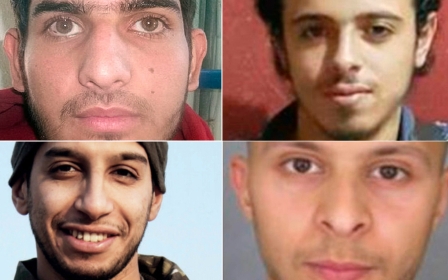Paris attacks 'bomb-factory' found in Brussels

Belgian police have found a Brussels flat where bombs used in the Paris attacks could have been made and where key suspect Salah Abdeslam may have hidden after the massacre, prosecutors said Friday.
Three hand-made belts for possible use in suicide attacks, traces of explosives and one of Abdeslam's fingerprints were discovered during a search in December of the apartment in the Schaerbeek area, they said.
The flat was rented by someone using a false name, possibly used by another suspect in the 13 November Paris attacks who is now in custody in Belgium, the federal prosecutor said.
Prosecutors said Abdeslam might have hidden in the flat after the 13 November attacks, but that they were also working on the theory that the explosive devices used in the massacre could have been made there.
"We found the fingerprint but we have no idea when it was left - a fingerprint has no date or time on it," prosecutors' spokesman Eric Van Der Sypt told AFP.
"Maybe he went there to get his belt (before the attacks), and maybe he went back afterwards. I suppose it's a possibility of both," he added.
An international manhunt has been underway for Belgian-born Abdeslam, 26, since suicide bombers and assailants firing automatic weapons killed 130 people and wounded many more in a wave of attacks across Paris.
Investigators said friends drove Abdeslam from Paris back to the Belgian capital, slipping through three police checks, while one suspect has since said that he drove Abdeslam across Brussels to Schaerbeek on November 14.
There was no sign of police activity on Thursday at the apartment block in the quiet Schaerbeek area, AFP journalists said. Residents said they were not aware of any raid in December.
Prosecutors said the raid was carried out "in the framework of the investigation opened after the Paris attacks". They did not explain why details were only being released a month after the search.
"During a house search conducted December 10th in an apartment on the third floor, Rue Berge in Schaerbeek, material that can be used to fabricate explosives as well as traces of TATP were found," the prosecutor said in a statement, referring to a type of explosive.
"This apartment was rented under a false identity that might have been used by a person already in custody in this case," the statement added.
"Three handmade belts that might be used to transport explosives as well as a fingerprint of Salah Abdeslam were also discovered."
Hunt continues
Prosecutors would not comment on Belgian media reports that the flat had been cleaned and checked for fingerprints after the attacks, which would explain why only one of Abdeslam's prints was found.
After the attacks, French authorities said that telephone data had placed Abdeslam in the area where an explosives belt was found in a dustbin in the Paris suburb of Montrouge.
The Islamic State group claimed responsibility for the coordinated series of attacks on bars, restaurants and a concert hall, in which the attackers were armed with guns and suicide belts. Seven died during the assault but the total number of those directly involved is still unclear.
One of them was Abdeslam's brother, Brahim.
In early December, Belgian prosecutors said they were looking for two "armed and dangerous" men who used false ID papers to help Abdeslam travel to Hungary in September where he was stopped - but then let go - by police.
Belgian authorities have arrested and charged a total of 10 people in connection with the attacks, including several with helping Abdeslam.
France has long said the attacks were prepared and organised in Belgium and that the mastermind was Abdelhamid Abaaoud, a Brussels resident who was killed in a police raid in Paris days after the massacre.
Middle East Eye propose une couverture et une analyse indépendantes et incomparables du Moyen-Orient, de l’Afrique du Nord et d’autres régions du monde. Pour en savoir plus sur la reprise de ce contenu et les frais qui s’appliquent, veuillez remplir ce formulaire [en anglais]. Pour en savoir plus sur MEE, cliquez ici [en anglais].





